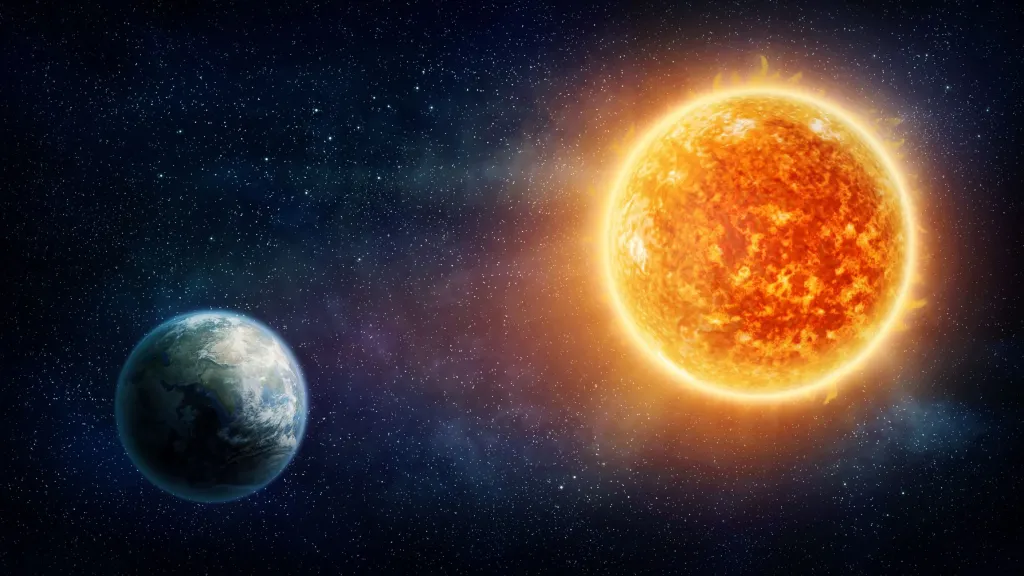A new study points to a fascinating and completely unexpected connection between Mars’ gravitational field and Earth’s climate. Geological records spanning more than 65 million years show that Earth’s deep-sea currents undergo repeated power cycles every 2.4 million years. These cycles, called “major astronomical cycles”, appear to be related to the gravitational interaction between Earth and Mars.
Earth’s climate and ocean currents
Deep-water currents, alternating between stronger and weaker phases, significantly affect sediment deposition on the ocean floor. During periods of stronger currents, often called “giant eddies” or whirlpools, these powerful movements reach very deep and wash away the sediments that have accumulated there. Results of a new study now shed light on how these cycles align with the gravitational interaction between Earth and Mars.
Dietmar Müller, one of the authors of the study, explains: “The gravitational fields of the planets in the Solar System interact with each other, and this interaction, called resonance, changes the eccentricity of the planets, a measure of how close to circular their orbits are.” a geophysicist. Professor at the University of Sydney.
Mars’ gravitational force towards Earth
Because of this resonance, the gravitational pull of Mars brings the Earth slightly closer to the Sun, resulting in increased solar radiation and a warmer climate. Over time, the Earth drifts backwards, completing this cycle approximately every 2.4 million years. This slight gravitational effect may play a role in shaping Earth’s long-term climate patterns.
Researchers used satellite data to map sediment accumulation on the ocean floor over millions of years. The team found gaps in the geological record; these gaps suggested that stronger ocean currents during warm periods caused by the Martian impact may have disrupted sediment deposition. These findings add to growing evidence that celestial mechanics, including Mars’ gravitational pull, influence Earth’s climate. However, the researchers explained that this warming effect is not related to current global warming caused by human greenhouse gas emissions.
“Our deep-sea data over 65 million years shows that warmer oceans have more intense deep circulation,” said study lead author Adriana Dutkiewicz, a sedimentologist at the University of Sydney.
Why does any of this matter?
The results of the study suggest that these cycles may help maintain ocean currents even in scenarios where global warming could weaken them. One such important current is the Atlantic Meridional Overturning Circulation (AMOC), often referred to as the ocean’s “conveyor belt.” This system transports hot water from the tropics to the Northern Hemisphere and contributes to the distribution of heat in the deep oceans.
“We know that there are at least two separate mechanisms that trigger intense deep-sea mixing in the oceans,” Muller said. he said.
Although some scientists predict a possible collapse of the AMOC in the coming decades, ventilation caused by deep-sea eddies could help prevent ocean recession.
Orbital mechanics — basics
Orbital mechanics in our solar system are like a cosmic dance choreographed by gravity. Every planet, moon, asteroid, and even a tiny speck of dust follows a specific path or orbit around a larger body due to gravitational forces. The orbital mechanics between Mars and Earth are their positions, speeds, and distances in the solar system, creating a fascinating relationship.
Also read – NASA discovered a hidden planet in the Kepler-51 system
Both planets orbit the Sun in elliptical paths, but Earth moves closer to the Sun and faster in its orbit. It takes Earth about 365 days to make one revolution, while the more distant Mars takes about 687 days to rotate.
This difference means that Earth “circulates” in its orbit around Mars every 26 months, creating opportunities for a close approach called opposition; In this case, Mars is directly opposite the Sun in the sky as seen from Earth.
These close approaches are of great importance for space exploration. When planning missions to Mars, scientists use efficient routes that are consistent with the relative positions of Earth and Mars. Orbital mechanics controls not only the journey itself but also the timing, ensuring we can send rovers, landers, and eventually humans to Mars with precision and efficiency.
Orbital mechanics and Earth’s climate
Although still speculative, this study of Mars’ gravitational pull highlights the potential for astronomical cycles to influence Earth’s climate and ocean circulation. This is in addition to the aforementioned coordination of space mission launch paths for previous and future Earth missions to Mars.
These discoveries highlight the relationship between planetary orbital mechanics and Earth’s natural systems and offer new insights into how space may shape our planet’s climate over millions of years. Understanding these interactions not only deepens our knowledge of Earth’s history but also sheds light on the resilience of ocean systems in the face of ongoing climate change.
“This would potentially prevent the ocean from stagnating even if the Atlantic meridional circulation slows or stops altogether,” Adriana Dutkiewicz concluded.
Earth can’t escape the influence of Mars’ gravity
Mars is smaller in size and mass than Earth and therefore its gravitational pull is weaker. But gravity on Mars still has a noticeable effect, in addition to affecting Earth’s orbit. The gravitational force on Mars is about 38% of that on Earth, meaning that an object or person weighs much less than if it were resting on the surface of Mars.
The reduced gravity affects the planet’s ability to maintain a thick atmosphere, resulting in a dry and barren Martian environment. Mars’ moons Phobos and Deimos also experience the planet’s gravitational pull, causing tidal forces to gradually change their orbits. Over millions of years, Phobos is expected to approach Mars and eventually break apart, forming a ring around the planet.
In addition, Mars’ gravity also affected spacecraft trajectories during missions that used a technique called gravity assist to propel the probes toward distant targets.
The interaction between Mars’ gravity and the dynamics of the solar system demonstrates the subtle but profound influence of this planet on neighboring celestial bodies. Researchers continue to explore how such forces may have shaped Mars’ history, including its ancient magnetic field and the potential for past water systems. The study was published in the journal Nature Communication.













